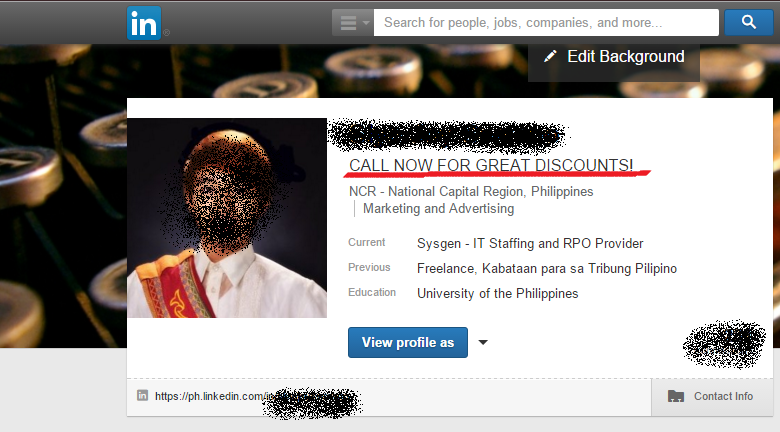LinkedIn is a community. It is a massive community of 350 million users (with 2 new members signing up every second) worldwide. It is a powerful community or platform for connecting with industry peers and other people who might add value to our knowledge and professional network. With LinkedIn’s blogging feature, anyone can also grow their thought leadership or learn from others in the LinkedIn community.
Fast Facts About LinkedIn:
- 95 percent of recruiters use LinkedIn to search for candidates;
- 95 percent use LinkedIn to contact candidates;
- 95 percent use LinkedIn to “keep tabs on” potential candidates;
- 93 percent use LinkedIn to ‘vet candidates pre-interview (versus 32 percent on Facebook and 18 percent on Twitter);
- 92 percent jobs on LinkedIn (versus 48 percent on Facebook and 39 percent on Twitter);
Yes, you can get plenty of benefits from LinkedIn if you are doing networking the right way. You can meet people who may have great opportunities for you, or opportunities may find you. But also, you can shoo opportunities away, or trash valuable prospective connections or learnings if you are unwary of the way you behave in the LinkedIn community.
As a community, LinkedIn is guided by values, such as professionalism, and unspoken rules. Could you be violating “standard operating procedure” on LinkedIn? Liz Ryan, a Fortune 500 HR SVP and writer, shared what she thinks are “don’t s” on LinkedIn.
Misrepresenting Yourself

Source: www.reddit.com
According to Liz Ryan, employers often encounter this problem with former employees who misrepresent what they did for the company. Executives think that by misrepresenting themselves, employees in effect cast their company in an ‘unflattering light.’
With over 300 million users and in the absence of a mechanism to check the accuracy of the data provided in the user’s profile, users can pretty much write whatever they want in LinkedIn.
Please be truthful about what information you provide in your profile. One way or another, people will find out if you are telling the truth or not, and lies have their own nasty ways of revealing themselves. Other than that, when you exaggerate your credentials and people begin asking you questions, they’ll know what you do and do not know eventually, so why lie?
Misusing LinkedIn Features
LinkedIn is a full-packed platform with many useful features for free. You can use these features (e.g. Pulse, headline, and Groups among others) to optimize your presence in the LinkedIn community, and land great opportunities. However, if you use these to annoy people in your network, you might end up losing connections, thus, opportunities.
Your professional headline on LinkedIn should not contain your phone or mobile number, or your email address. And, marketing pitches are not meant for your professional headlines, too (e.g. “Call Now For Best Rates!”, “STORE CLOSING, SALE THIS WEEKEND ONLY!”).
Marketing pitches have been forced down our throats our whole life, so give your connections some break. Without you realising it, putting those annoying call to actions in your LinkedIn header might lose you connections and opportunities instead. So, relax. Connect sincerely (or at least, seemingly sincere).
Spamming People

Source: foxadhd.tumblr.com
Spamming people in LinkedIn is easy, as it is in other social media platform. Once connected you can easily storm people with your marketing pitches. But that is a lame move. DO NOT SPAM PEOPLE using LinkedIn. Your reputation will suffer and you’ll get nothing at the end of the day.
Tip: If you really want to market something or someone, make great contents not pitches. Entice your readers to check out what you have to offer. This society is fed up with advertisements forced down our throats.
There are various ways to spam or annoy people online, such as adding people to your mailing list without their permission (expressed through subscription), or emailing people with your latest blog posts (every single one of it every time!).
Adding People To Your Newsletter Mailing List (without their permission)

Connection is not synonymous to subscription, so when someone connects to you on LinkedIn, it does not mean that you have the permission to add them to your newsletter subscriber list. Who wants to read tons of emails everyday from subscriptions they never remember subscribing to.
TIP: If you really wish to share your great thoughts with your network, then contact them first, invite them nicely. You owe your peers that courtesy. You may want to send a quick email message like this:
Dear Maria,
Thanks for accepting my LinkedIn invitation. I’m honored to be part of your network. Please let me know how I can help you reach your goals!
I have a question for you. May I have your permission to send you my monthly newsletter? In the newsletter, I write about the latest developments in the recruitment process outsourcing.
If that sort of thing is not your cup of tea, I’ll understand completely.
Thanks and have a great day Maria,
Remar
That’s nice and suave, isn’t it?
Emailing People Your Latest Blog Post

Source: Giphy.com
One of the many great features of LinkedIn is the LinkedIn Pulse which functions like a blogging platform. In the Pulse, you can write articles and publish them. It’s a great avenue to start your thought leadership and add value to your network.
At LinkedIn, a publisher (or blogger) already has an audience (millions in fact). If you are making great content then it wouldn’t be difficult to make a following. BUT BUT BUT … never make it a habit of sending your LinkedIn connections emails whenever you post something new in the Pulse, because if your connections already followed your blog on LinkedIn, then LinkedIn already sent your connections a notification about your new post. So, try not be too nosy, or seem spammy to your connections.
Connecting With People to Invade Their Network

Source: giphy.com
Okay, imagine this. You like Maria, but she’s not your friend, and not even your acquaintance. You hesitate to approach Maria because you think so highly of her and you are intimidated by her. Maria’s friend, Anna, seems more approachable, and more friendly. So you befriended Anna. But soon after getting Anna’s friendship, you immediately asked her to introduce you to Maria. And then Anna, effectively became…sort of… a bridge from you to Maria. And you and Anna just became friends like three days ago! How do you think does that look? Tactful? No, my friend, it’s lame. It’s impolite. If I were Anna, I’ll feel used!
It’s easy to forget about relationships, genuine relationships, when we are so pegged at a goal — a transaction we want to commence with somebody in our new connection’s network. This transactional view of relationship does not cultivate good and lasting partnership. Immediately asking your new connection of an introduction to one of her connections is impolite.
There’s nothing wrong with asking for introductions. You just have to do it the right way, and… at the right moment. In LinkedIn, why not talk you to your friend over the phone, or tip some cans of Sprite and fill her or him in on your job search. And then, ask them whether they would be comfortable thinking about anyone they know who’d be a good person for you to meet.
That’s a nicer thing to do instead of joining someone’s network and then start hitting up their friends for introductions without getting their permission. But if you are polite, and courteous enough to approach them properly, they’d be willing to help you out. We bet on it!
Stealing Introductions

Source: xylark.tumblr.com
Introduction-stealing is reaching out to your connection’s connections directly. So, it’s bypassing your first connection and going after your connection’s connections. What is terrible about stealing introductions is that you will, often times, be used.
Imagine this: A friend of yours calls you in the middle of day saying somebody named “John” called her and said you told “John” to call her, and that John is a friend of yours. You don’t know any John, until you remember accepting an invitation to connect from somebody named John. But he isn’t your friend. And you certainly did not tell him to call one of your friends. Isn’t that embarrassing and at the same time annoying? Yes, it is. Unfortunately, there are people who do that.
Never steal introductions. Genuine connection or friendship is a thousand fold better than making up a false story just to get in touch with someone you want to transact with. Go beyond transactions, and foster genuine professional relationships instead.
Trust and goodwill power communities, all kinds of communities. Without it, a community’s existence is in doubt. LinkedIn is a powerful network, it’s a beneficial tool. So, let’s keep this community beneficial for everyone and make each day at LinkedIn a day of celebrating the greatness of our individual craft as professionals.
Source:
Ryan, Liz. ‘Eights Ways To Be Rude And Unprofessional On Linkedin’. Forbes.com. N.p., 2015. Web. 22 Sept. 2015.


